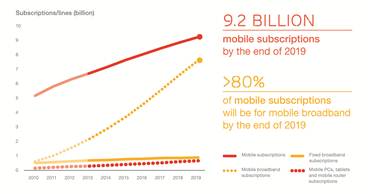Ericsson’s latest report on mobility shows growth in the machine-to-machine space, as well as the continued dominance of smartphones in the device market and significant regional divides in the coverage of LTE.
“We see cellular M2M taking off,” said Rima Qureshi, SVP and chief strategy officer for Ericsson. “Over time, cellular M2M services and applications related to, for example, intelligent transport systems, will require very short latency in order to be efficient. By 2019 we estimate that more than 20 percent of the active cellular M2M devices will be connected to LTE subscriptions. We also see new device-to-device and M2M applications as a key focus of 5G networks.”
In 2016, the company said, smartphones subscriptions will outnumber basic phone subscriptions. Ericsson noted that 65% of all the phones sold in the first quarter of 2014 were smartphones. By 2019, smartphone subscriptions are expected to reach 5.6 billion. In Europe, smartphone subscriptions are predicted to reach 765 million and exceed the European population in 2019.
Long Term Evolution networks covered about 20% of the world’s population in 2013, Ericsson said, and that number is expected to grow to more than 65% by 2019. Ericsson’s report also delved into regional differences in LTE coverage, and in usage for wireless technologies. LTE coverage in Northeast Asia is expected to reach 95% of the population by 2019. In China, Ericsson predicts more than 700 million LTE subscriptions by 2019, which will represent more than 25% of the total global LTE subscriptions. Europe will have significant population coverage of 80%, but only about 30% LTE subscription coverage, compared to 85% in North America in 2019, according to Ericsson’s figures.
In a webinar accompany the report announcement, Arun Bhikshesvaran, chief marketing officer of Ericsson, noted that not only are there differences in LTE coverage, there are regional differences in mobility service usage. In China, he said, mobile phones are the primary way that people access and browse the Internet. Communication purposes, including voice, dominate in Korea, he said, while users in Japan focus on productivity apps, social media and general web access.
Bhikshesvaran also said that the industry should expect “significant migration” to Voice over LTE (VoLTE), because it gives operators the capacity to do more than traditional voice, including Rich Communications Services, as well as make networks more modern and efficient. However, he said that the adoption of VoLTE in any given country will depend not only on LTE coverage, but on the device mix and service combinations to prompt an operator to launch.
In some markets, such as Latin America, the good coverage and decent speeds already offered by HSPA will likely mean slower evolution to LTE, Bhikshesvaran added. Ericsson’s report expects LTE coverage in Latin America to remain less than 50% by 2019.
Other findings include:
- Mobile subscriptions continue to grow. There were 120 million net additions in the first quarter of 2014 alone, with a growth rate of 7% year-over-year. In 2015, Ericsson said, the total number of mobile subscriptions will exceed the world’s population. Mobile broadband subscriptions are expected to reach 7.6 billion by the end of 2019, and make up more than 80% of total mobile subscriptions.
- Data growth will continue to skyrocket, driven by video; Ericsson expects a 10-fold growth in mobile data traffic between 2013 and 2019. As more smartphones come onto wireless networks, those devices will also be used to consume more data: Ericsson said that a smartphone user in 2019 is likely to use nearly four times the amount of mobile data attributed to a current smartphone user.
- M2M will also be an underlying driver of the increased data traffic.
Ericsson has also created a Traffic Exploration Tool with the data set that underpins the report, which allows users to create customized graphs and tables filtered by region, technology, device type and other variables.

